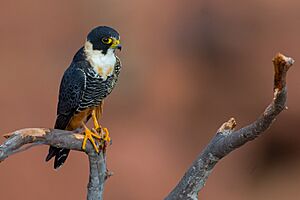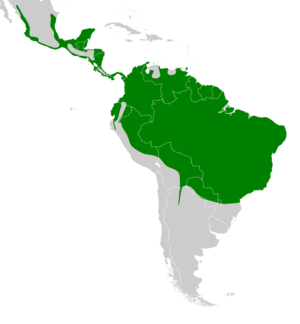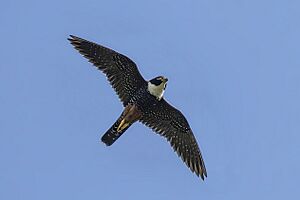Bat falcon facts for kids
Quick facts for kids Bat falcon |
|
|---|---|
 |
|
| Conservation status | |
| Scientific classification | |
| Genus: |
Falco
|
| Species: |
rufigularis
|
 |
|
| Synonyms | |
|
|
The bat falcon (Falco rufigularis) is a speedy bird of prey. It belongs to the Falconidae family, which includes falcons and caracaras. You can find these birds in Mexico, Central America, Trinidad, and almost all of South America. They are known for their amazing hunting skills, especially at dawn and dusk.
Contents
Meet the Bat Falcon
What is a Bat Falcon?
The bat falcon is a type of falcon. It's a medium-sized bird with long wings and a long tail. They are very fast flyers. These birds are called "bat falcons" because they often hunt bats. But they also eat many other things!
Bat Falcon Family Tree
Scientists group animals to understand them better. The bat falcon has a few different types, called subspecies. Think of them like different breeds of dogs. These are:
- F. r. petoensis
- F. r. rufigularis
- F. r. ophryophanes
Some scientists think the bat falcon is closely related to the orange-breasted falcon. They look and sound similar.
What Does a Bat Falcon Look Like?
Bat falcons are not very big. They are about 23 to 30 centimeters (9 to 12 inches) long.
- Males weigh about 108 to 150 grams (3.8 to 5.3 ounces). Their wingspan is 51 to 58 centimeters (20 to 23 inches).
- Females are a bit bigger. They weigh 177 to 242 grams (6.2 to 8.5 ounces). Their wingspan is 65 to 67 centimeters (26 to 26 inches).
Both male and female bat falcons look alike. They have a blue-black head and back. Their throat and upper chest are white or light brown. The rest of their chest is black with thin white stripes. Their belly and legs are a reddish-brown color. Their tail is black with thin white stripes.
Their eyes are dark brown. The skin around their eyes and their beak area (called the cere) are bright yellow. Their legs and feet are orange-yellow. Young bat falcons look a bit duller and browner than adults.
Where Do Bat Falcons Live?
Bat falcons live in warm, tropical places.
- The F. r. petoensis subspecies lives from northern Mexico all the way south through Central America. You can also find it in parts of Colombia, Ecuador, and Peru.
- The F. r. rufigularis subspecies lives in Trinidad, Venezuela, and parts of South America like Brazil and Argentina.
- The F. r. ophryophanes subspecies lives in central Brazil and nearby countries.
Sometimes, a bat falcon might fly far from its usual home. For example, one young male bat falcon from Mexico visited Texas in the United States! This was a very rare sighting.
Bat Falcon Homes
Bat falcons love tropical forests. They prefer thick, old forests. But they can also live at the edge of forests, in wooded grasslands, or even in towns and cities with some trees. They usually live from sea level up to about 1,700 meters (5,600 feet) high.
How Do Bat Falcons Behave?
Moving Around
Bat falcons usually stay in one area. They don't migrate far like some other birds. However, sometimes they do wander to new places. This explains why one was seen in Texas, or on islands far from the mainland.
What Do Bat Falcons Eat?
Bat falcons are amazing hunters! They often sit high up on a dead tree or branch. From there, they quickly fly out to catch their prey in the air. They also hunt while flying around. They hunt a lot around sunrise and sunset, and sometimes even after dark.
Their diet is very varied. They eat:
- Bats (that's how they got their name!)
- Birds like swifts, swallows, hummingbirds, and parakeets.
- Small animals like rodents, snakes, lizards, and frogs.
- Large insects such as dragonflies, butterflies, moths, and beetles.
While they eat many insects, larger animals like birds and bats make up most of their food. Young falcons are fed lots of insects by their parents.
How Do Bat Falcons Raise Their Young?
The time when bat falcons lay eggs changes depending on where they live.
- In Mexico, they breed from February to June.
- In Trinidad, they breed in February.
- In Argentina, it's likely between October and February.
They usually make their nests in holes in trees. These holes might be natural or made by parrots. Nests are often very high up, from 10 to 50 meters (33 to 164 feet) above the ground. They might also use old nests made by other birds, or even nest on cliffs or old ruins.
A female bat falcon usually lays two to four eggs. The eggs hatch after about 30 days. The young falcons can fly (fledge) when they are about 35 to 40 days old. They stay with their parents for at least 12 weeks after they learn to fly. Both parents help hatch the eggs, but the female does most of the work. The male brings food for the female and for the baby falcons.
Bat Falcon Calls
Bat falcons are quite noisy, especially when they are breeding or near their nest. They also call when they see other birds of prey or when they are hunting.
Their main call is a fast, high-pitched scream like kee-kee-kee... or kew-kew-kew.... The male's call is higher than the female's. They also make other sounds, like a very high tsee-tsee-tsee... or a soft chit sound. Females might make a whining call too.
Are Bat Falcons Safe?
The IUCN (International Union for Conservation of Nature) says the bat falcon is a species of "Least Concern." This means they are not in immediate danger of disappearing. There are at least half a million adult bat falcons, but their numbers might be slowly going down.
They are common in the right habitats. However, in some areas, forests have been turned into farms. This means bat falcons can no longer breed there. Also, pesticides (chemicals used to kill insects) have affected their breeding in Mexico and Central America.



